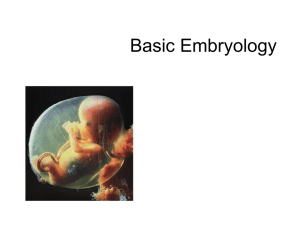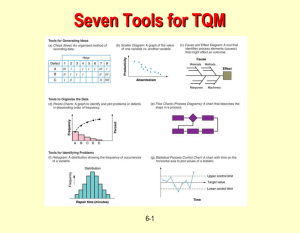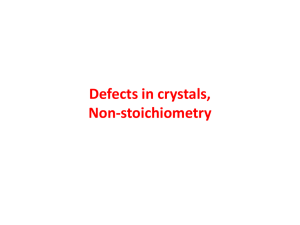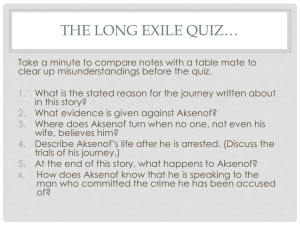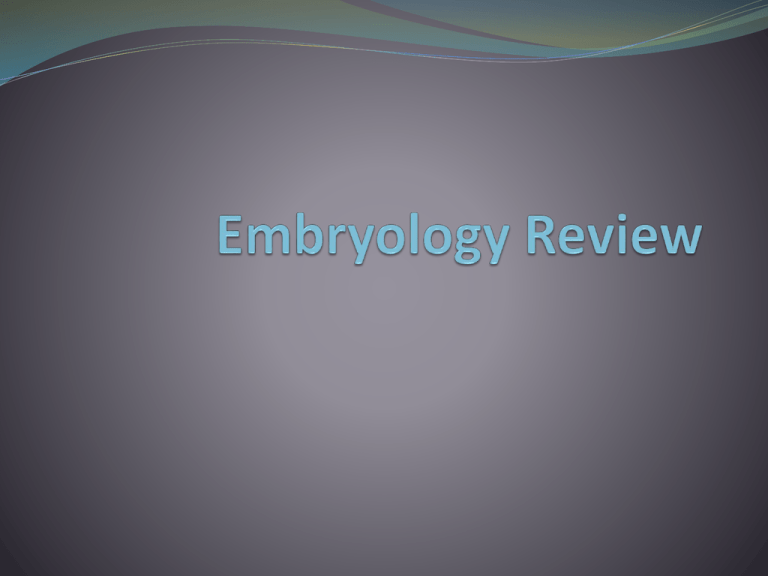
Timeline: 0 to 3 weeks
Day 0 to wk 3: all or none phase
Insults to the fetus at this time will result in loss of embryo or
will cause no damage.
Day 0: fertilization (initiation of embryogenesis)
Sperm + egg =zygote
Up to wk1: blastocyst implantation
By wk 2: bilaminar disk (2 germ layers: epiblast, hypoblast)
2 cavities: amniotic cavity, yolk sac
2 placental components: cytotrophoblast, syncytiotrophoblast
Rule of 2’s
At this time, the mother will miss her period
Timeline II: 3 to 10 weeks
• Wk3-8: Organogenesis (highest teratogen susceptibility)(90% of defects)
By wk3: gastrulation: (rule of 3’s)
Primitive streak
Notochord (becomes nucleus pulposus of intervertebral disks)
Induces neural plate/neuroectoderm formation
Mesoderm
Neural PlateNeural Tube formation: folate deficiency causes spina bifida here
3 germ layers: endo, ecto and mesoderm
Wk 4 (day 28): heart beat (4 chambers), 4 limb buds, 4 branchial arches
rule of 4’s, but tongue, lungs, GI and diaphragm also begin formation then
Week 4-6 is the critical period for TA, VSD, ASD, etc.)
Wk 4-5: limb defect critical period
Wk 5-6: cleft lip critical period
Wk 5-7: gonad differentiation, kidney, bladder, rectum formation
Wk 6-7: teeth/palate critical period
Wk 8: fetal movement, fetus looks like a baby, critical period for formation of
external genitalia
Wk 10: Genitalia are recognizable as female/male
The Timeline: Animated
All-or-None Phase: <3wks
Fertilization
Organogenesis (3 to 8 weeks)
Implantation of the
BLASTOCYST into the uterus at
up to 1 wk post fertilization
Wk 6: palate and teeth
Wk 8: fetal movement
Defect: external genitalia
Wk 3 gastrulation: Rule
of 3’s2 : rule of 2’s
Week
3 germ layers: ectoderm,
mesoderm,
*bilaminar
diskendoderm
of 2 germ layers: epiblast and hypoblast
Neural plate formation*2 cavities: amniotic cavity and yolk sac
Defect: spina bifida (incomplete
of the neural
tube
*2 placentalclosure
components:
syncytiotrophoblasts,
cytotrophoblasts
This is when the mother will miss her period
Wk 4: rule of 4’s
Wk 5: kidney, bladder, rectum and
4 limb buds, 4 branchial
gonadal differentiation (5-7)
arches
Defect: cleft lip (5-6)
Heart beat
Wk 10: Recognizable External Genitalia
Defects: heart (4-6), limb
(4-5)
Timeline Quiz!
How long after fertilization does the blastocyst implant
within the uterine wall?
1 week or less
What structures does the embryo have at 2 weeks?
Rule of 2’s: a bi-laminar disk, 2 cavities, 2 placental components.
Cavities: amniotic cavity and yolk sac.
What is the significance of the All-or-None phase?
Any teratogen exposure either does not affect the fetus or the fetus
is lost.
How long is the All-or-None phase? 3 weeks after
fertilization, until organogenesis.
Timeline Quiz II !
What phase comes after the All-or-None phase?
Organogenesis
How long is Organogenesis?
Weeks 3-8 (5-6 weeks)
What percent of structural defects occur during weeks 3-8?
90%
What structures form during week 3?
Rule of 3’s: 3 germ layers: ecto, meso, endoderm.
Timeline Quiz III !
What is the defect associated with teratogens in week 3?
Spina bifida (failure of closure of the neural tube)
What structures form during week 4?
Rule of 4’s: 4 limb buds, 4 branchial arches
What are the defects associated with weeks 4 and 5, and 4-6?
Wk 4-5: limb
Wk 4-6: heart defects, including VSD, ASD, TA
What structures form during week 5?
Limbs, heart (still forming), and gonads, kidney, bladder and rectum.
Timeline Quiz IV !
What defect is associated with week 5?
Cleft lip
What structures form during weeks 6-7?
Teeth and palate
What happens in week 8?
External genitalia differentiate, fetus moves and looks
like a baby.
Timeline Quiz V: Last One!
What is the significance of week 10?
External genitalia has differentiated to the point where
one can determine whether one’s baby is a boy or a girl.
When do you first hear the fetal heartbeat?
Week 4 (Day 28)(1 month)
When is the first fetal movement?
Week 8 (Day 56) (2 months)
Germ Layers
Note: while this chart from the NIH
has the yolk sac and amniotic
ectoderm arising early, the boards
books and Dr. Darnell want you to
think about their derivation as
follows:
Yolk sac: endoderm and mesoderm
Amnion: ectoderm and mesoderm
Presumably the extraembryonic
germ layers later gain mesoderm.
Germ Layers: Ectoderm
Ectoderm
Surface ectoderm
Epidermis, epithelia of (skin, ear, eye and nose),hair and nails, lens of
eye, enamel of teeth
Adenohypophysis, mammary glands, sweat glands
Neuroectoderm (Neural tube)
CNS neurons, oligodendrocytes, astrocytes, ependymal cells
Neurohypophysis, pineal gland
Neural crest cells (also included initially in neuroectoderm)
Autonomic (SNS/PNS) NS, dorsal root ganglia, Schwann cells
Odontoblasts (dentin and pulp of teeth), parafollicular C cells of the
thyroid
Melanocytes, adrenal medulla chromaffin + enterochromaffin cells
Pia and arachnoid mater, skull bones except for the occiput, laryngeal
cartilage
Septum of truncus arteriosus that forms part of the ascending aorta and
pulmonary trunk
Germ Layers: Meso & Endoderm
Mesoderm
Dura mater, CT: perineal body, serous epithelia, blood vessels,
lymphatics, blood, spleen
Somites, muscle, bone, heart, kidneys, adrenal cortex, gonads
Notochord (induces neuroectoderm formation from
surrounding ectoderm)
Extraembryonic membranes
Endoderm (GI tract/gut tube-pharynx, esophagus,
stomach, sml and large intestines, cloaca)
Lungs, liver, pancreas, thymus, parathyroid, thyroid follicular
cells, lining of inner ear
Lining of yolk sac and allantois
Yolk sac remnant –vitelline duct, Meckel’s diverticulum
Extraembryonic Membranes
Chorion and Amnion
Ectoderm
Mesoderm
Yolk Sac and Allantois
Mesoderm
endoderm
Germ Layer Defects
Mesoderm defects: (VACTERL)
Defects: vertebral, anal atresia, cardiac, tracheo-esophageal fistula,
renal, limb defects
Ectoderm defects: hypophoic ectodermal dysplasia syndrome
Neural crest cell (usually migration) defects:
DiGeorge Syndrome/CATCH22/22q11 syndromes
Neurofibromatosis Type 1 (NF1 gene, ch17)
Café au lait spots associated with PNS tumors
Pheochromocytomas
Hirshsprung’s disease
VSDs, defect in NC truncus arteriosus septation
Lack of neurons in colon, digestive defects
Wardenburg syndrome
Sensory neural deafness with GI defects (Hirshsprungs +)
Germ Layers Quiz 1 of 5
The bilaminar disk epiblast differentiates into what
embryonic germ layers?
Ecto, meso, endoderm
The hypoblast differentiates into what?
Extraembryonic endoderm, which becomes part of the
yolk sac.
The yolk sac is made of hypoblast extraembryonic
endoderm and what other germ layer?
Mesoderm.
Germ Layers Quiz 2 of 5
The allantois is derived from what?
Mesoderm and endoderm
The Amnion is derived from which two germ layers?
Mesoderm and extraembryonal ectoderm.
The Chorion is derived from which two germ layers?
Mesoderm and ectoderm.
What are the three divisions of the embryonic ectoderm?
Surface, neuroectoderm and neural crest cells.
Germ Layers Quiz 3 of 5
Name five things derived from surface ectoderm?
Skin, teeth enamel, hair and nails, eye lens
Adenohypophysis and glands (mammary and sweat)
From neuroectoderm?
CNS: neurons, glia, ependymal cells, oligodendrocytes, pineal
gland, neurohypophysis
From neural crest cells?
Peripheral nervous system: ganglia, neurons and Schwann cells
Bones and membranes of the skull: pia, arachnoid mater (all except
dura and the occiput bone)
Septum of truncus arteriosus (separates pulmonary trunk from
aorta
Parafollicular C cells of the thyroid
Odontoblasts: dentin and pulp of the teeth
Adrenal medulla chromaffin cells
Enterocromaffin cells
Melanocytes of the skin
Germ Layers Quiz 4 of 5
Name at least 5 things that are derived from
mesoderm.
Bones, muscle, connective tissue, adrenal cortex, spleen,
blood vessels, heart, kidneys, serous epithelia, gonads
Name 5 things derived from endoderm.
Lung, pancreas, GI tract, thymus, inner ear lining
What germ layer is associated with VACTERL?
Mesoderm
Germ Layers Quiz 5 of 5!!!
What does VACTERL stand for?
Vertebral
Anal atresia
Tracheo-Esophageal fistula
Renal
Limb defects
Cardiac
Name 4 defects associated with ectodermal dysplasia.
CATCH22/22q11/DiGeorge syndromes
Hirshsprung’s disease
Wardenburg’s disease
Neurofibromatosis Type 1
The Heart
The process of heart formation
2 heart tubes form and
combine to form one
heart tube (mesoderm)
The tube loops
Blood originally enters
from the bottom, but
after folding enters at
the top (r. atrium)
Pump begins to work
(heartbeat at day 22, the
beginning of week 4)
Ventricle/Atria Formation
Cardiovascular II
Ventricular Septum development
Muscular ventricular septum forms
Interventricular foramen links ventricles
Aorticopulmonary septum divides the truncus
arteriosus into aortic and pulmonary trunks
NC cell migration is crucial for this action
The MV septum fuses with the AP septum to form the
membranous interventricular septum, which closes the
interventricular foramen.
Atrial Septation
The septum primum
forms first, allowing the
right to left shunt.
The septum secundum forms
second, remaining as the
foramen ovale after the septum
primum degenerates leaving
only the valve seen here.
Completed around wk 9.
The muscular septum grows
After birth, this is closed due to
upwards to divide the
decreased right atrial pressure
interventricular foramen
and increased left atrial
pressure.
The muscular septum eventually
The remnant is the fossa ovalis.
fuses with the membranous
septum, which grows down from
the aorticopulmonary septum.
Completed by about week 8.
Cardiovascular III
Atrial septal development
Foramen primum narrows
Septum primum grows towards the endocardial cushions
Foramen secundum forms in septum primum
Maintains the Right to Left shunt
Septum secundum begins to grow
Permanent foramen ovale is part of the SS
Septum primum degenerates, leaving the valve of the
foramen ovale
Cardio IV: Erythropoesis
Erythropoesis
3-8wks: yolk sac
6-30wks: liver
9-29wks: spleen
28 wks +: bone marrow
Fetal hemoglobin is alpha-2-gamma-2 (not a2b2!)
Cardio V: Circulation
Umbilical vein blood is 80% O2 sat.
Joins lower body venous blood after the fetal liver (ductus venosus)
(65%o2)
Umbilical artery blood has less (O2 sat. 57%)
Still enough to supply lower body, but head gets the best blood
3 shunts (close at birth):
Ductus venosus: conducts blood entering the fetus via the umbilical
vein to the fetus IVC.
Foramen ovale: conducts most of the oxygenated blood in the IVC
(from the ductus venosus) to the left atrium/ventricle from the right
atrium.
Ductus arteriosus: conducts blood from the pulmonary artery to the
descending aorta. This is in large part deoxygenated blood from the
SVCright atrium, ventricle.
The Umbilical Cord
Umbilical cord (Allantois gives rise to everything
except yolk sac)
Umbilical vein (into fetus)
Umbilical arteries (2)(from fetal internal iliac arteries)
Yolk sac-disappears by week 7 except for small vesicle
Gives rise to some of the umbilical cord
Urachus
Removes waste from fetal bladder to allantois
Wharton’s Jelly: surrounds vessels and urachus,
encapsulated by amniotic epithelium
Cardio VI
The first breath
Lungs expand: decreased resistance in pulmonary vasculature
Decreases right atrial pressure and increases left atrial
pressure
Foramen ovale closes becomes fossa ovalis
Increased o2decreased PGs, Ductus arteriosus closes
Umbilical vein no longer contributes (also lowers RA
pressure)becomes ligamentum teres hepatis and the
superior vesicular aa.
Portal sinus closes
Ductus venosus closes, becomes ligamentum venosum
Postnatal Derivatives
Umbilical vein
Ligamentum teres hepatis (falciform ligament)
Umbilical arteries
Medial umbilical ligaments
Allantois
UrachusmediaN umbilical ligament
Remnant of the allantois: urachal cyst or sinus
Urachus: duct between bladder and umbiliacus
Yolk sac Meckel’s diverticulum
Postnatal derivatives II
Ductus arteriosus
Ligamentum arteriosum
Ductus venosus
Ligamentum venosum
Foramen ovale
Fossa ovalis
Notochord
Nucleus pulposus of intervertebral disks
Postnatal Derivatives III
Truncus arteriosus
Ascending aorta, pulmonary trunk
Bulbus cordis
Smooth parts of LV and RV
Primitive ventricle
Trabeculated parts of LV/RV
Primitive atria
Trabeculated left/right atria
Postnatal Derivatives IV
Left horn of sinus venosus (SV)
Coronary sinus
Right horn of sinus venosus
Smooth part of right atrium
Right common cardinal vein
SVC
Right anterior cardinal vein
SVC
Endocardial cushions (NC derivatives)
Separate the atria from the ventricles
Heart Quiz! 1 of 3
How many heart tubes do we start with?
2
And then what happens?
They join and fold forward, bunching into an atrium
and a ventricle, separated by cardiac cushions.
When does the pump function?
Beginning of week 4
How do the 2 ventricles form?
The muscular septum joins the membranous septum to
close off the interventricular foramen by week 8.
Heart Quiz II of III
How do atria form?
The septum primum forms, leaving a hole called the foramen
secundum. Then the septum secundum forms, leaving a hole
called the foramen ovale. The septum primum degenerates
(thins).
How does this right left shunt close after birth?
Decreased right atria pressure and increased left sided
pressure after the first breath causes the foramen ovale to be
closed.
What are two other shunts in the fetal circulation?
Ductus venosus: umbilical vein to IVC
Ductus arteriosus: pulmonary trunk to aorta
Heart Quiz III of III
What do the umbiliacaL arteries become after birth?
Medial umbilical ligament.
What does the allaNtois become after birth?
Median umbilical ligament
What is a yolk sac remnant called?
Meckel’s diverticulum, vitelline duct
Summary: Cardiac Defects
ASD, VSD, AV Canal and persistent truncus arteriosus are holes in the
septa
They cause LR shunts after birth, which result in right ventricular
hypertrophy, pulmonary hypertension, and if severe, congestive heart
failure/death
Why are we looking? Sx: fatigue, failure to thrive
Eisenmenger’s syndrome: R L shunt, results in cyanosis
Eventual result of physiological response to LR shunt: pulmonary
hypertensionRV and RA hypertrophy.
Solves the LR shunt by overcompensating: now blood flows RL without going
to the lungs first!
Dx: Look at the heart=echocardiography
Tx: Holes in the heart=surgery
Tetralogy of Fallot= actually 5 things: VSD, PDA, pulmonary stenosis,
RV hypertrophy, overriding aorta
Cardiovascular Defects
ASD (Atrial-septal defect)
If foramen ovale and foramen secundum are not staggered,
they cannot be closed when pressure forces the septum
primum and septum secundum together at birth.
The foramen ovale remains patent, blood shunts LeftRight
This leads to Right sided atrial and ventricular hypertrophy,
pulmonary hypertension and arrhythmias
The hypertrophy minimizes the LR shunt
Prevalence: 6/10,ooo, greater with Down’s, trisomies,
chromosomal aberrations
Dx: echocardiography, systolic murmur with fixed S2 split
Tx: surgery-insert occluding device or close hole
More Cardio Defects
VSD (Ventricular septal defect)
Prevalence: 12/10,000 but represents 25% (1/4) of all cardiac
defects. (Most common cardiac defect)
Results in LeftRight Shunt
Results from any of the following
Failure of fusion of the muscular and membranous ventricular septa
Insufficient muscular septum
Deficiency of the proximal conotruncal swellings
Failure of the endocardial cushions to fuse
Dx: echocardiography, audible murmur
Sx: failure to thrive, fatigued baby, CHF (congestive heart
failure)
Tx: surgery
Cardiac Defects III
Persistent AV Canal
Often seen in Down’s syndrome
Failure of endocardial cushion fusion, leads to ASD and
VSD
Results in LR shunt
Dx: echocardiography
Sx: CHF (more severe), pulmonary hypertension(slightly
less severe)
Tx: Surgery
Cardiac Defects IV
Cotruncal defects
Persistent truncus arteriosus (prevalence: 1/10,000)
Conotruncal septa (NC cells) fails to form
VSD plus no clear aorta/pulmonary trunk= lots of LR shunting
after birth
Dx: cyanosis at birth, systolic ejection murmur at left sternal border
Sx: pulmonary hypertensiondeath by age 2
Tx: surgery
Transposition of the great vessels (prevalence: 5/10,000)
Most common cause of death from cyanotic heart disease
Results from failure of rotation of conotruncal septa, resulting in
non-connected pulmonary and systemic circulations.
Dx: echocardiography
Tx: surgery: requires PDA(give PGE2), ASD or VSD for survival of
baby
Cardiac Defects V
• Tetralogy of Fallot (~22q11 deletions)
• Prevalence: 10/10,000, increased with 22q11 deletion
• Unequal division of outflow tract= PDA plus
•
•
•
•
•
1. pulmonary stenosis
2.RV hypertrophy
3.VSD ( RV hypertrophy)(results in overriding aorta)
4.Overriding aorta
The PDA lets blood from the aorta back into the pulmonary trunk.
Patent ductus arteriosus
Indomethacin helps close the DA
Elevated prostaglandins can keep DA patent. (bad)
Drug related cardio defects
Lithium Ebstein anomaly- tricuspid valve is displaced in right
ventricle, towards apex of heart
The aorta is positioned
over a VSD, so it
receives blood from
both ventricles
= 5 things!
PDA
A narrowing of the
normal outflow tract of
the right ventricle can be
due either to increased
muscular growth of the
wall or a secondary result
from the
VSDoverriding aorta
The aortic and LV blood
flowing back into the
pulmonary/RV system results
in RV hypertrophy and
pulmonary hypertension
1. Patent
ductus
arteriosus:
aortic blood
flows back to
pulmonary
trunk!
The VSD results from
failure of fusion of the
membranous and
muscular septa and results
in a LR shunt after birth.
Cardiac Defects Quiz!
Describe the Tetralogy of Fallot.
5 : VSD, PDA, RV hypertrophy, pulmonic stenosis, overriding aorta
What is the Ebstein anomaly and what causes it?
Lithium causes a misplaced tricuspid valve
What are common symptoms in a newborn with a heart defect?
Fatigue, failure to thrive, possible cyanosis
Name two types of cotruncal defects and differentiate between them.
Persistent TRUNCUS arteriosus: failure of NC migration: no
aorticopulmonary septa.
Transposition of the great vessels: failure of rotation: septa makes right
heart blood go to aorta. Tx: keep ductus arteriosus patent with PGE2.
Both cotruncal defects present with cyanosis and are fatal if not
surgically treated.
The Lungs
Respiratory
Diaphragm (mesoderm)(wk4) derived from
Septum transversum
Pleuroperitoneal folds
Failure of pericardiopleural canal closure can result in diaphragmatic
hernia
Body wall
Dorsal mesentery of esophagus (mesenchyme)
Innervation: C3,4,5 keep the diaphragm alive
Lungs bud from foregut endoderm at day 28/wk4
Secondary bronchial buds at day 30
Tertiary bronchial buds at day 38
Respiratory II-Diaphragm
Esophageal mesenchyme
Body wall
Pleuroperitoneal membranes
Septum transversum
Respiratory development defects
Congenital diaphragmatic hernia (prevalence:
4/10,000)
incomplete diaphragm formation results in abdominal
contents herniating into thorax
May result from lack of diaphragm muscle or failure to close
of the left pericardioperitoneal canal
Hypoplasia of thoracic organs(lungs, heart)
Tx: surgery in utero (fatal at birth-scaphoid/hollowed
abdomen)
Respiratory Defects II
Neonatal RDS(respiratory distress syndrome)
Failure of surfactant production (<26wks at birth)
Lungs cant inflate: sx: gasping, cyanosis, asphyxiation
Tx: surfactant replacement
Pulmonary Hypoplasia
Diaphragmatic herniation/insufficiency
Uretric bud obstruction or other kidney loss
Congenital hiatal hernia (limits urine production)
Oligohydraminos (limits urine production)
Lungs Quiz!
What happens if there is a problem with kidney development?
(to the lungs)
Hypoplasia
Why would a baby be born with not enough surfactant?
Less than 26 weeks gestation (RDS)
What 4 embryonic structures form the diaphragm?
Septum transversum (mostly), body wall, pleuroperitoneal
membranes (2), esophageal mesenchyme
From what and when do the lungs bud?
The proximal foregut in week 4 (week of heartbeat)
Digestive Tract
GI
Thyroid: late week 5 -buds down from the foramen cecum of the
center of the tongue.
Functional at wk 10-12
Pancreas- Ventral and dorsal buds fuse
Ventral bud: head, main pancreatic duct
Dorsal bud: body and tail, accessory pancreatic duct
Spleen-arises from dorsal mesentery
Rotation of the GI tract(peritoneum fixes final position)
90 degrees counterclockwise
Around the s. mesenteric artery as the gut tube extends into the belly
stalk (physiologic herniation)
Then, 180 degrees counterclockwise (starts at wk10)
Gut reenters the abdomen, midgut being positioned on the left side
(cecum, ascending colon)
GI Blood supply
Three gut divisions/Three unpaired arteries
Foregut: stomach to first 1/3 of duodenum
Celiac artery
Midgut: last 2/3 of duodenum to ascending colon
Superior mesenteric artery
Hindgut: transverse colon to rectum
Inferior mesenteric artery
GI Defects
Tracheoesophageal fistula (part of mesodermal defects)
Though endodermal, these are associated with mesodermal defects
because mesoderm coats the gut tube and is, in part, responsible for
signals for growth/differentiation.
Polyhydraminos, milk to the lungs and/or air to the stomach,
asphyxiation/drowning
Thyroglossal Cyst/Sinus- the tube through which the thyroid descends
remains patent and may fill with fluid.
Pyloric stenosis: larger (more muscular)sphincter, smaller opening at
opening to duodenum
Sx: infant (2-6w) with non-bilious post prandial vomiting, failure to
thrive
Dx: palpable olive-sized mass in the epigastric region
Increased prevalence in males, non-blacks (dominant polygenic
inheritance)
GI defects II
Annular pancreas: wraps duodenum, results from bilobed ventral
pancreatic bulb
Results in duodenal stenosis, gut malrotation, imperforate anus,
polyhydraminos, pancreatitis/GI obstruction, jaundice
Associated with Shh autosomal recessive -/-, Down’s syndrome
Dx: UGI, CT, Ab Xray or ultrasound
Tx: bypass surgery
Volvulus: torsion from malrotation or failure to be secured
Increased risk in Duchenne’s muscular dystrophy
Sx: bilious vomiting, pain, GI bleed,
Results in acute obstruction with vessel/lymphatic compression,
necrotic/stenotic bowel, venous engorgement
Dx: upper/lower GI study, X-rays
Tx: surgery
GI Defects III
Meckel’s diverticulum (omphalomesenteric fistula, cyst or ligament
from failure of regression of the vitelline duct remnant of the allantois)
Rule of 2s: 2% of population, 2% of which have sx, 2x more males, dx:
2yrs old
2ft from ilium, 2 inches long, 2 types of abnormal lining
In 2% of those that have it, presence of inappropriate gastric/pancreatic
tissue causes self-digestion or adhesions
Sx: peritonitis, appendicitis, ulcer, adhesions may lead to bowel
obstruction
Tx: treat infection, remove offending tissue (surgery)
Omphalocele 2.5/10,000
Persistent herniation of abdominal contents through umbilicus
Gastroschisis: 1/10,000
herniation of abdominal contents through abdominal folds
Due to failure of lateral body folds to fuse
GI Quiz!
Where and when do the thyroid form?
Migrates down from the center of the tongue by week 12:
Starts in late week 5.
What does each pancreatic bud become in the adult
pancreas?
Ventral: Head and main pancreatic duct
Dorsal: Body, tail and accessory pancreatic duct
What two rotations are necessary for healthy GI
formation?
90 degrees counterclockwise, then 180 counterclockwise
by wk10
GI Quiz II!
What are the three arteries of the foregut and what parts do
they supply?
Foregut: celiac
Midgut: s. mesenteric
Hindgut: i. mesenteric artery
Name a GI defect associated with VACTERL mesodermal
problems.
Tracheoesophageal fistula, can result in polyhydraminos
What's the difference between gastroschisis and
omphalocele?
Gastroschisis: prevalence 1/10,000, abdominal herniation
through abdominal folds instead of the umbilicus with
omphalocele, which is more common at 2.5/10,000.
GI Quiz III
Meckel’s diverticulum (yolk sac remnant) has what
characteristics?
Rule of 2’s: 2% of population, 2% of which have sx(adhesions, self
digestion), 2x more males, dx: 2yrs old, 2ft from ilium, 2 inches
long, 2 types of abnormal lining
What is a thyroglossal cyst?
A remnant of the path of the descent of the thyroid.
What is pyloric stenosis?
The pyloric sphincter wont let food out of the stomach
What pancreatic defect is associated with a sonic hedgehog
mutation?
Annular pancreas
Urinary and Genital
*see supplementary ppt for more detail on this system
Urogenital formation
Intermediate mesoderm divides cloaca into rectum and bladder,
urethra and vagina (females)
Intermediate mesoderm mesonephric ducts
Uretric bud: kidney, ureters
The rest of the mesonephric duct:
Forms the trigone of the bladder
Wolffian duct (males): Seminal vesicles, ductus deferens
Paramesonephric ductsMullerian ducts: uterus, top of vagina,
fallopian tubes
Sex determination (male: SRY gene initiates)
Estrogen: male brain
Testosterone: internal male genitalia
DHT: external male genitalia
Urogenital Defects
Anal atresia (part of mesodermal defects)(see TE
fistula)
Incomplete partitioning
Blind end rectum
Urachal fistula, cyst, or sinus can result in urine
from umbiliacus
Exostrophy of bladder
Failure of penis formation in males
Genital Defects
XX male/XY female 1/20,000
Wnt4, Dax, SRY or receptor abnormalities
Dx: karyotyping, physical exam
Sx: infertility
Tx: surgical correction often does not affect fertility
Pseudohermaphroditism
XY female with androgen insensitivity or MIF resistance
Testes may become trapped in the broad ligament
Other causes: CAH, mosiacism, 5a reductase deficiency
Sx: infertility, gonadal tumors
Tx: controversial surgery
More Genital Defects
Potter’s syndrome/sequence (1/3000)
No metanephros/kidney (renal agenesis)
No urinepulmonary hypoplasia, limb deformities
(sirenomelia/Mermaid syndrome), wrinkled skin, atypical
facial features
100% fatal a few days after birth
Horseshoe kidney (1/400)
Renal fusion can increase risk of obstruction, stones, cancer
Increased risk with Turner’s syndrome
Usually Dx’d at autopsy
Even More Genital Defects
Pelvic kidney (failure to migrate up)
Cryptorchidism: failure of testes to descend~ with
increased rates of testicular cancer
Hypospadius: urethra opens on the inferior aspect of the
penis (Epispadius is above)
Uterine anomalies: failure of fusion of the Mullerian tubes:
bicornate, septated uterus
Unicornate uterus
Cervical atresia
Sx: infertility
GU Quiz!
From what do the male reproductive ducts form?
Wolffian ducts
From what do the uterus and female reproductive
ducts form?
Mullerian ducts
What happens if the Mullerian ducts fuse improperly?
Bicornate, unicornate uterus, cervical atresia
From what does the bladder/rectum form?
From intermediate mesoderm, which divides the cloaca
into bladder and rectum
GU Quiz II!
What genetic changes can result in XX males or XY
females?
Wnt4, DAX, SRY or their receptor genes
Name two causes of pseudohermaphroditism
Androgen insensitivity
Mullerian Inhibiting Factor resistance
What is Potter’s Syndrome?
No kidney and look like a mermaid. But you die.
How prevalent is horseshoe kidney?
1/400
The Brain and the Branchial Arches
Nervous System Formation
Day 18-21(wk3): Neural plate folds to form the neural tube
Alar plate(dorsal): sensory
Basal plate(ventral): motor
Neural Plate Neural tube Brain
Expands in front to form telencephalon, diencephalon (forebrain
Mesenchephalon (midbrain)
Metencephalon, myelincephalon (pons, cerebellum, medulla)
Craniofacial : Eye formation
Pax6 gene in the optic placode, optic cup(retina), optic stalk
Lens buds in
Brain Development
Telencephalon:
cerebral cortex, caudate
nucleus ,putamen,
amygdala
Prosencephalon(forebrain)
Diencephalon:
thalamus,
hypothalamus, retina
Mesencephalon(midbrain)
Mesencephalon:
midbrain
Metencephalon:
pons, cerebellum
Rhombencephalon(hindbrain)
Myelencephalon: medulla
Craniofacial formation: Branchial
Arches
Branchial /Pharyngeal Arches (mesoderm)
Begin developing at week 4
Ectoderm on outside, endoderm on inside
Between arches, ectoderm contacts endoderm (pharyngeal membrane)
Forms tympanic membrane (b/w BA 1 and BA 2)
Branchial arches/Pharyngeal arches
Face: Muscles of the face, Palatine tonsil
Tongue (1,3,4 BA)
Ear
The inner ear/Eustachian tube
Incus, malleus and stapes
Glands: Thymus, Parathyroid
Parafollicular C cells of the thyroid
Branchial Arch One: Mandibular
Arch
muscles of mastication
tensor tympani
tensor veli palatini maxilla
mandible (only as a model for mandible not actual
formation of mandible)
the incus and malleus of the middle ear
Meckel's cartilage
Innervation: Trigeminal nerve (V2 and V3)
Blood: Maxillary artery
Branchial Arch Two: Hyoid Arch
Muscles of facial expression
buccinator
platysma
stapedius
stylohyoid
Stapes of middle ear
styloid process,
hyoid (lesser horn and upper part of body),
Reichert's cartilage
Innervation: Facial nerve (VII)
Blood: Stapedial Artery
Branchial Arch Three
Stylopharyngeus Hyoid (greater horn and lower part of
body)
thymus
inferior parathyroid gland
Innervation: Glossopharyngeal nerve (IX)
Blood: Common carotid/Internal carotid
Branchial Arch Four
cricothyroid muscle
all intrinsic muscles of soft palate including levator
veli palatini
thyroid cartilage
epiglottic cartilage
superior parathyroid gland
Innervation: Vagus nerve (X),Superior laryngeal nerve
Blood: Right side: subclavian artery Left side: aortic
arch
Branchial Arches 5 & 6
intrinsic muscles of larynx except the cricothyroid
muscle
cricoid cartilage
arytenoid cartilages
corniculate cartilage
Innervation: Vagus nerve (X),Recurrent laryngeal
nerve
Blood: Right side: pulmonary artery Left side:
Pulmonary artery and ductus arteriosus
Pharyngeal/Branchial Arches
Endoderm
PA-PP1tubotympanic
(insidecavity
the future
recesstympanic
of middle
throat
of
the
fetus)
ear, auditory/Eustachian tube
-connects middle ear to pharynx
PA-PP2 and PM2: forms palatine
tonsil, infiltrated by lymphoid
tissue during mo 3-5 (week 12-20)
Pharyngeal Pouch
PA-PP3Dorsal- inferior parathyroid
glands, must migrate to future
location, source of ectopic
PA-PP4parathyroid glands
Dorsalsuperior gland
parathyroid
Ventral-Thymus
glands
Ventral- Ultimobranchial body/5th
PA, migrates to thyroid, implants
to form C/parafollicular cells of the
thyroid. (secretes calcitonin)
Mesoderm
The first
Ectoderm (neural tube)
pharyngeal arch
also gives rise to the
Pharyngeal cleft
incus and malleus
of the middle ear
Pharyngeal membrane
1
2
Palatine Tonsils
Stapes
Inferior parathyroid gland
3
Thymus
gland
Superior Parathyroid Glands
4
Ultimobranchial
bodygland
C cells of the thyroid
6
Pharyngeal Arch
Craniofacial Development Defects
Clefts
Ear defects (wk 4-10)
Conductive hearing loss (external or middle ear)
Sensorineural hearing loss (inner ear, CN VIII, CNS)
150 genes implicated (50% environmental factors)
Craniostenosis: abnormal fusion (early or late) of cranial
sutures
Frontal:
Sagittal: tall head
Lambdoid: broad head
Coronal: bulging forehead
Eye Defects
Coloboma: pupil extends to the edge of the iris
Aphakia: no lens
Aniridia: no iris
Congenital cataracts (~rubella)
Anophthalmia: no eye/eyes
Strabismus: eyes are not aligned
Neuro Defects
Neural Tube Defects
Failure to close
Anencephaly: missing a portion of brain
Spina bifuda occulta: brain exposed, herniating
Holoprosencephaly (Cyclops)
Forebrain does not divide to right/left hemispheres
Can get one eye, a nose above the eye, a single nare, a
cleft palate, extra midline tooth
Neuro Quiz!
What does BA1 make?
Incus and malleus, eustachian tubes, middle ear
BA2?
Stapes, palatine tonsil
Ventral BA3?
thymus
Dorsal BA3?
INFERIOR parathyroid glands
Neuro Quiz II of II
Ventral BA4?
Parafollicular C cells of the thyroid
Dorsal BA4?
SUPERIOR parathyroid glands
What nerves innervate each arch?
1: V2/V3 (five), 2: VII(seven), 3: IX(nine), 4: X(ten)
What are the 5 embyonic divisions of the nervous
system?
Telencephalon, Diencephalon, Mesencephalon,
Metencephalon, Myelencephalon
Muscles and Bones
Musculoskeletal (somites)
Limb patterning:
3 axes, outgrowth based on gradient of expression,
apical ectodermal ridge
Arm ahead of leg
Homeobox genes, Shh
Ear Bones
Incus, malleus BA1
Stapes BA2
MS Somites II-The Tongue
From Pharyngeal/Branchial arches 1,3,4 (wk 4)
1: anterior 2/3
From median tongue bud (tuberculum impar) and the lateral lingual swellings
Innervation:
Sensory: lingual nerve, a branch of V3 (PA 1)
Taste: CN VII, chorda tympani (PA2)
3: posterior 1/3
With 4th arch, forms the pharyngeal/hypobrachial eminence
Innervation: Sensory and Taste: CN IX (PA3)
4: base of the tongue, innervated by CN X (PA4)
Occipital somites (mesoderm) form muscles of tongue
(intrinsic/extrinsic) (CN XII)
Thyroid (ecto/endoderm)
Originates at the foramen cecum at the center of the border between
the anterior and posterior tongue.
Innervation: CN V, VII, IX, X, XII (ectoderm)
Musculoskeletal defects
Meromelia/Phocomelia: no leg between foot and hip
Amelia: Missing limb
Achondroplasia
Split foot
Syndactyly/Polydactyly
Patau’s syndrome (ch13)
Omphalocele 2.5/10,000/Gastroschisis (when body wall
closes behind intestines) 1:10,000
Weak abdominal wall allows herniation
Can result in bowel injury:malabsorption/obstruction
Volvulus, reflux
Tx: surgery
MS Quiz!
Which grows first from the limb buds, arm or leg?
Arm
What genes govern limb growth?
Homeobox genes, Sonic hedgehog
Which branchial arches contribute to the ear bones?
BA1: incus, malleus
BA2:stapes
What chromosome is associated with the polydactyly of
Patau’s syndrome?
C13
MS Quiz II
Which branchial arches form the tongue?
1,3 and 4
What part of the tongue does BA1 form?
Anterior 2/3
What part of the tongue does BA3 form?
Posterior 1/3
What part of the tongue does BA4 form?
The base
What forms the skeletal muscles of the tongue?
Occipital somites (mesoderm)
MS Quiz III
What nerve innervates the part of the tongue created by
the first branchial arch?
Sensory: lingual nerve, a branch of V3 (PA 1)
Taste: CN VII, chorda tympani (PA2)
What nerve innervates the part of the tongue created from
the 3rd branchial arch?
Sensory and Taste: CN IX (PA3)
What nerve innervates the skeletal muscles of the tongue?
CN XII
Teratogens and Genetics
Teratogens and Genetics
Increased risk during organogenesis (3rd-8th wks)
Common teratogens
EtOH (FAS)
Leading cause of congenital malformations
pre and postnatal developmental retardation
Microcephaly
Facial abnormalities
Limb dislocation
Heart/lung fistulas
Mechanism: inhibition of cell migration (likely)
Teratogens II
Teratogens
ACE- (Renal damage)
Cocaine (Fetal addiction and abnormal development)
DES (diethylstilbestrol) (Vaginal clear cell carcinoma)
Iodide (Hypothyroidism, congenital goiter)
Vitamin A/Retinoids
Thalidomide (limb defects)
Tobacco (preterm labor, ADHD, placental problems) ?
Warfarin
X-rays
Anticonvulsants
Fetal Infections
Genetics
Uniparental disomy
Double non-disjunctions results in two chromosomes from one parent
only (none from other parent)
Imprinting
Phenotype dependent on whether gene was inherited from mom or dad
(different methylation of germ cells)
Example: single locus ch15 with only one allele active at a given time.
(the other is inactivated by methylation) If the active allele is deleted,
disease results.
Prader-Willie (deletion of normal paternal allele 15q11-q13)
Obesity, hypogonadism, hypotonia, infertility and mental retardation
Angelman’s (Happy Puppet) syndrome (deletion of mom’s allele of
15q11-q13)
Seizures, ataxia, speech impairment, inappropriate laughter, mental retardation
Twinning
Separate chorions and amnions
19% MZs, 58% DZ
Fused but separate chorions and amnions
13% MZs, 42% DZ
Single
1 chorion, 2 amnions
64% of MZs
1 chorion, 1 amnion
4% of Mza
Most MZs share a chorion but not an amnion
Most DZs have separate chorion and amnion
Mosaicism: chimerism due to fusion of two embryos
Teratogens and Genetics Quiz!
What do monozygotic twins share that dizygotic twins don’t?
A chorion
Name 5 abnormalities associated with FAS
Microcephaly, lung/heart fistulas, developmental retardation, facial
abnormalities
What’s Prader-Willie Syndrome?
Congenital obesity, hypogonadism, mental retardation 15q11-13
DAD deletion
What’s Angelman Syndrome?
Happy Puppet Syndrome! 15q11-13 MOM allele deletion: seizures,
ataxia, mental retardation, inappropriate laughing
What is the difference between the effects of DAD/MOM’s
alleles called?
Imprinting
Summary Quiz!
Timeline Quiz
When do you see the most structural defects?
Wks 3-8
When do you get heart defects?
Wk 4-6
When do you get limb defects?
Wk 4-5
When do you get cleft lip/palate defects?
Wk 5-7
When do you get external genitalia defects?
Week 8
Germ Layers Quiz
What ectodermal defect can occur in week 3?
Spina bifida
What type of ectodermal dysplasia is associated with
failure of neural crest cell migration?
Hirschsprung disease, Wardenberg disease,
Neurofibromatosis 1, CATCH22/DiGeorge syndrome.
What mesodermal defects can occur?
VACTERL
What extraembryonic structures contain endoderm?
Yolk sac and Allantois, with mesoderm
Cardiovascular Quiz
What forms the interventricular septum?
The muscular and membranous septa.
When is the foramen ovale developed?
By week 9
What is the Tetralogy of Fallot?
A quintet of defects that center around a VSD and a
PDA: overriding aorta, pulmonic stenosis, pulmonary
hypertension.
When would a PDA save the life of a child?
When they have transposition of the great vessels
Respiratory Quiz
What's so bad about a congenital diaphragmatic
hernia and how does this affect treatment?
Prevents complete formation of lungs and heart
(hypoplasia of thoracic organs) and is fatal at birth
unless surgery is performed in utero.
When do the diaphragm and lung buds first form?
Week 4
Why do premies often experience respiratory distress?
Failure of surfactant production
Gastrointestinal Quiz
What are the rotations that the gut must complete and
what happens if they don’t rotate correctly?
90 counterclockwise followed by 180 counterclockwise
or they get volvulus and can rupture
What is annular pancreas?
Pancreas wrapped around the duodenum
What are the three arteries of the GI tract from
stomach to colon?
Celiac, S. mesenteric, I. mesenteric
Genitourinary Quiz
Urachal fistula can result in what unfortunate occurrence
in XY’s?
Failure of penis formation
What germ layer forms the gonads and internal genitalia?
Intermediate mesoderm
What is pseudohermaphroditism?
Phenotype(external) doesn’t match gonads (internal)
Name 5 causes of pseudohermaphroditism?
5a reductase deficiency, mosiacism, CAH, androgen
insensitivity, MIF resistance
Neurological Quiz
What is holoprosencephaly?
Cyclops disease
Name 3 eye defects.
Aniridia: no iris
Anopthalmia: no eye
Aphakia: no lens
Coloboma: pupil transverses iris.
What is craniostenosis?
Abnormal fusion of cranial sutures: weird shaped head.
Name two types of hearing loss.
Sensorineural (CNS/CN defect)
Conductive(outer/middle ear defect can be BA defect)
Branchial Arches Quiz
What does branchial arch one develop into?
Incus, malleus, middle ear
What nerve innervates it?
CN V
BA2?
Stapes, palatine tonsil
What nerve innervates it?
CN VII
BA3?
Inferior parathyroid glands and thymus
What nerve innervates it?
CN IX
BA4?
Superior parathyroid glands and thryroid C cells
What nerve innervates it?
CN X
Musculoskeletal Quiz
What nerves innervate the tongue?
CN V3, VII, IX, XII
What genes cause limb patterning?
Homeobox, Shh
When do the limbs bud?
Wk 4
What do you call it when the limbs form wrong?
Amelia (no limb), Phoco/Meromelia (short limb)
Syn/Polydactyly(extra digits)
Teratogens/Genetics Quiz
Describe Imprinting
Father’s loss of allele has a different effect than mother’s allele
loss, due to differential methylation.
Name 5 drugs that cause congenital defects
Lithium-Ebstein anomaly
ACE inhibitors
Warfarin
What's a difference in the surroundings of monozygotic
twins v. dizygotic twins?
What is uniparental disomy?
Getting two alleles from one parent and none from the other.
Yay! You are done with Embryo!!
Bibliography
Podcast and ppt.
First Aid
Wikipedia
Kaplan embryology
http://amazingbeauty.org/embUNC/embUNC-
heart.html (great embryo of the heart animations)
http://www.med.unc.edu/embryo_images/unitwelcome/welcome_htms/contents.htm (images of all
body system formation)


